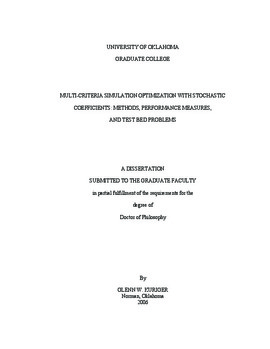| dc.contributor.advisor | Grant, Hank, | en_US |
| dc.contributor.author | Kuriger, Glenn W. | en_US |
| dc.date.accessioned | 2013-08-16T12:20:25Z | |
| dc.date.available | 2013-08-16T12:20:25Z | |
| dc.date.issued | 2006 | en_US |
| dc.identifier.uri | https://hdl.handle.net/11244/1111 | |
| dc.description.abstract | Three methods were developed to solve multi-criteria simulation optimization problems by adapting and extending genetic algorithms (GA), tabu search (TS), and lexicographic Nelder-Mead (LNM) methods. These modifications were accomplished largely by incorporating simulation and using goal programming. All three methods included a memory component to ensure that each solution was only simulated once per replication of the method. The three resulting methods were the GA simulation optimization (GA-SO) method, the TS simulation optimization (TS-SO) method, and the LNM simulation optimization (LNM-SO) method. These methods were designed to address multiple objectives, but they could also be used to handle single objective problems. | en_US |
| dc.description.abstract | In general, all five test bed problems, all three multi-criteria simulation optimization methods, and all four global performance measures performed well. | en_US |
| dc.description.abstract | Currently, there are not sufficient performance measures to allow for the effective comparison of simulation optimization methods. To address this need, this research proposed four global performance measures to allow for the analysis and comparison of simulation optimization methods. These global performance measures examined the computational efficiency, the quality of solution, and a combination of the efficiency and quality. There were two measures used to evaluate the computational efficiency or the computational speed. The representative operation counts (ROC) were evaluated at two separate points: the number of calls to the simulation model required to complete the method (ROCCM) and the number of calls to the simulation model required to find the best solution (ROCBS). The quality of solution was evaluated based on the best solution found (BSF). The overall performance of a method was determined based on a combination of the computational speed and the quality of solution. A formula was determined for a performance measure called the time-quality estimator (TQE). | en_US |
| dc.description.abstract | A test bed of problems was also developed to allow for current and future simulation optimization methods to be evaluated based on the same set of test problems. Five problems were developed representing five different domains. These problems included the inventory, logistics, PERT, production, and reliability domains. | en_US |
| dc.format.extent | xiv, 396 leaves : | en_US |
| dc.subject | Engineering, Industrial. | en_US |
| dc.subject | Computer simulation. | en_US |
| dc.subject | Mathematical optimization. | en_US |
| dc.subject | Programming (Mathematics) | en_US |
| dc.title | Multi-criteria simulation optimization with stochastic coefficients: Methods, performance measures, and test bed problems. | en_US |
| dc.type | Thesis | en_US |
| dc.thesis.degree | Ph.D. | en_US |
| dc.thesis.degreeDiscipline | School of Industrial and Systems Engineering | en_US |
| dc.note | Adviser: Hank Grant. | en_US |
| dc.note | Source: Dissertation Abstracts International, Volume: 67-10, Section: B, page: 5991. | en_US |
| ou.identifier | (UMI)AAI3238430 | en_US |
| ou.group | College of Engineering::School of Industrial and Systems Engineering | |
